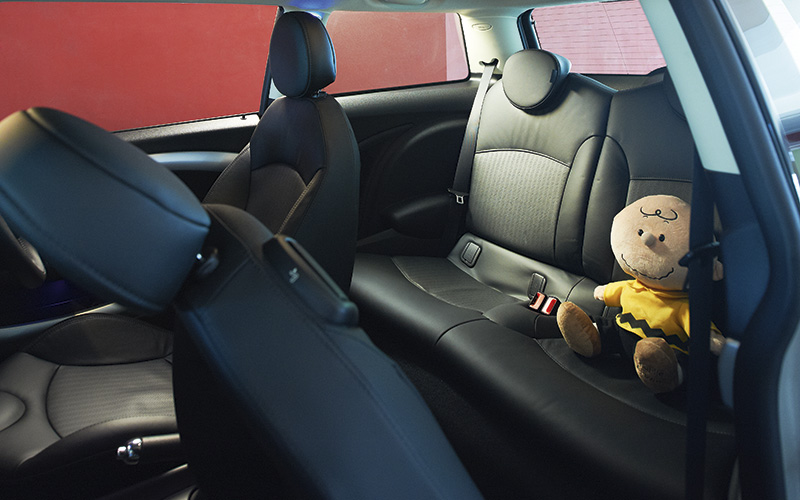
The icons of this world are made, not born. Before she became the blonde sex symbol Marilyn Monroe, Norma Jean Mortensen was your average brunette. Her rise to fame did not happen overnight, either – she had to make a name for herself and get noticed in order to win starring roles in hit movies.
The same is true in the automotive world. Cars can be sales sensations, but this alone cannot guarantee icon status. To achieve this distinction, their popularity must endure the test of time. For the classic Volkswagen Beetle and Mini Cooper, this “longevity challenge” was tough, because both models began their lives as utilitarian, no-frills runabouts.

Mr Lego-head has more storage space than the Volkswagen’s Beetle Box.
Of the two, it is the original Beetle that has humbler origins. Designed by Ferdinand Porsche (founder of the sports car marque that bears his name), the Beetle was initially not even given a name when it was launched in 1938. It was just called a “Volkswagen”, which literally means “people’s car”. And its purpose was equally simple: to provide a cost-effective, economical and reliable form of transport to the masses.
Porsche’s wagon for the German people comes with a rear-mounted, rear-wheel drive flat-4, air-cooled so it doesn’t need a radiator, which could leak and cause overheating. Totally “reversed” is the modern Beetle, which has a front-mounted, front-drive and liquid-cooled inline-4. As per the German trend these days, the 1.2-litre is turbocharged, but it doesn’t produce the same offbeat note of yore – sentimental drivers have to play their Beatles songs (on a compact disc rather than a cassette tape, of course) through the optional Fender hi-fi instead.

The original Mini came later, in 1959, but its mechanical makeup was more radical than that of the Beetle, already 21 years old by then. The Mini was the first production car with a transversely mounted engine, its gearbox and differential placed alongside in a bold departure from the norm. The front-drive tyke didn’t need a propeller shaft and a transmission tunnel, so its floor could be flat and its interior space more generous than the exterior dimensions would suggest (just over three metres long from bumper to bumper).
The present-day Mini (Cooper, in this case) still has a transversely mounted inline-4 and a front-drive layout, but it’s otherwise a far cry from its forerunner created by Sir Alec Issigonis. Nurtured by BMW and taken upmarket, the British baby is all grown up now, but it no longer subscribes to the packaging formula of “tiny outside, big inside”, which is a pity.

Also a world apart from what came before is the Beetle cabin, which boasts touchscreen infotainment and other conveniences. An obvious link to the past is the Beetle Box, a top-hinged bin, but unlike yesterday’s version (which could swallow several atlases), today’s interpretation can only hold a pair of sunglasses.

He’s no blockhead – Charlie really digs the Beetle’s Fender beat.
Likewise, the Mini cockpit has gone from uncomplicated to sophisticated. A round design theme dominates, with circular elements throughout. From the air-con vents to the hi-fi speakers, the numerous circles are enough to make your head spin – assuming you’re not already overwhelmed by the size of the speedometer, which looks five times bigger than the one in the vintage Mini. Keeping the driver dizzy with excitement are the nostalgic toggle switches.

The Beetle and Mini were “remade” in another way – respectively, they starred in popular Hollywood remakes of 1968’s The Love Bug and 1969’s The Italian Job.
Herbie reprised its role as the loveable racecar that could think and act independently of its owner, with a cameo by the New Beetle, while the Mini Cooper again carried stolen gold bars, but through the streets and sewer tunnels of Los Angeles instead of Turin, Italy. Taking the place of historical “Italian Jobbers” Michael Caine and Noel Coward were Mark Wahlberg and Charlize Theron, with the third “lead actor” being BMW’s blatant product placement in the 2003 flick.

Having a big-name actor or actress behind the wheel of a car makes it go from blue-collar zero to popped-collar hero in no time at all. In the Singapore context, however, you’re more likely to see a Beetle (new-new, new or old) being driven leisurely rather than hurriedly, and the only back street the modern Mini will be storming is Haji Lane.
Even though the latter-day Beetle and Mini are more retro performers than reborn icons, they nevertheless put up a wonderful wayang show for chic drivers.
This story was first published in the October 2012 issue of Torque.
Group Test: New Volkwagen Beetle Cabriolet 1.2 vs Old Volkswagen Beetle Cabriolet 2.0












